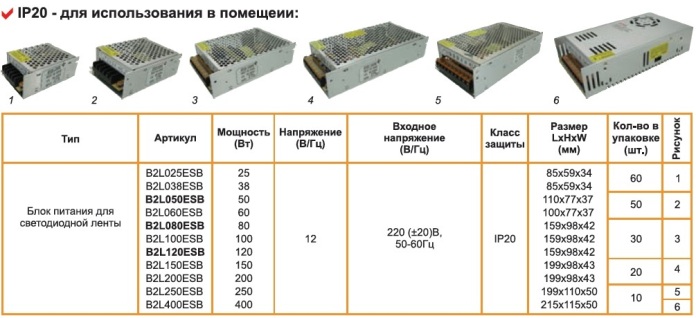Categories: Featured Articles » Sources of light
Number of views: 20948
Comments on the article: 0
How to calculate and choose a power supply for a 12V LED strip
LED strip allows you to organize lighting and lighting. When using models with 220V power, a small adapter with a diode bridge inside is needed to connect. But to connect 12V or 24V low voltage LED strip you will need a power supply. And for multi-color models, there’s also a controller. We will talk about how to choose and calculate the power supply for the LED strip in current and power in this article.
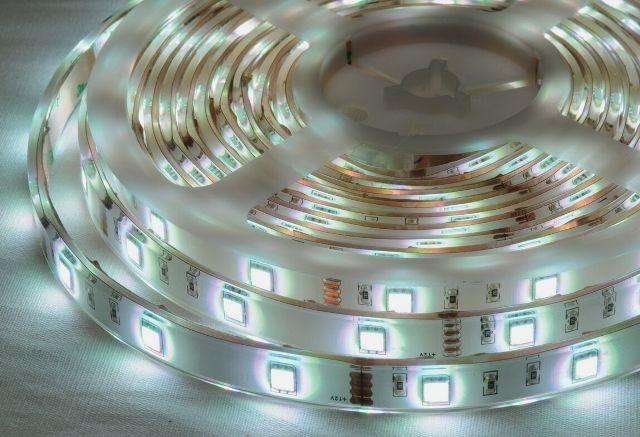
Kinds
All of the following is true for a common 12V LED strip, as well as for models with a 5V or 24 volt supply voltage.
Before proceeding to the calculation of the power supply for the LED strip, you need to determine where it will be installed, it depends on which option to pay attention to.
According to the cooling method, two types of power supplies are distinguished:
-
With active cooling;
-
Passive cooled.
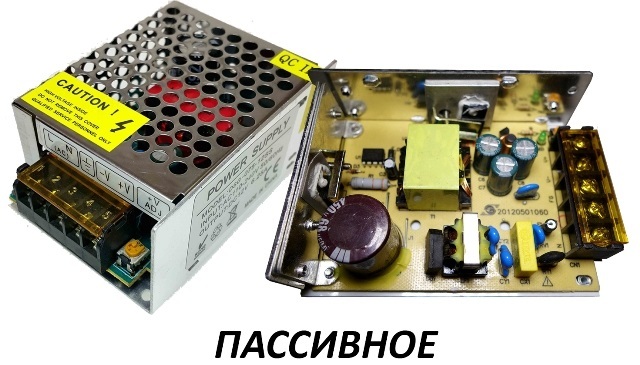

Active cooling consists of radiators and a fan (a cooler similar to those installed in computers). The advantages of this system are that the radiators on the power elements are used in smaller sizes, which means that the power supply will be smaller and lighter than the power supply with passive cooling of the same power.
However, the good weight and size characteristics of active-power supply units overlap with a significant drawback - over time, the cooler starts to work louder and louder, due to mechanical wear. Therefore, it is not recommended to use them in residential premises, since the hum during operation can cause discomfort to the user.
Active cooling power supplies usually have large power - from 100 watts or more, which is why they are great for connecting backlights in large rooms, public places or for connecting LED installations of large lengths, for example, for street lighting (facade, billboards and etc.) from one source.

Passive power supplies are produced in a wide range of capacities, but models with a capacity of up to 100-150 watts are most widely used. Their advantage is that they are silent in work. Therefore, they can be installed without hesitation in the bedroom or other living room. The sizes of such devices are usually larger than that of active power supplies.
On the market you can find products that differ in dust and water resistance class (IPxx class), for example, IP22, IP44, IP67. I prefer to divide them into two types:
-
Sealed (IP65 and above) or the so-called "street" power supplies for LED-strips. Their case often resembles a laptop power supply (black plastic block), and high-power sealed power supplies are made in a metal casing with caps at the ends.
-
Not airtight. These are those that are carried out in a plastic non-sealed case or in a metal case with perforation through which air convection is carried out when the elements are cooled.

When you have decided where you will install the unit, what protection class is needed and in what power range these units are sold, you can proceed to the calculation of the power supply circuit of the LED strip.
How to calculate the power supply
To get started, check out the power chart of typical LED products.
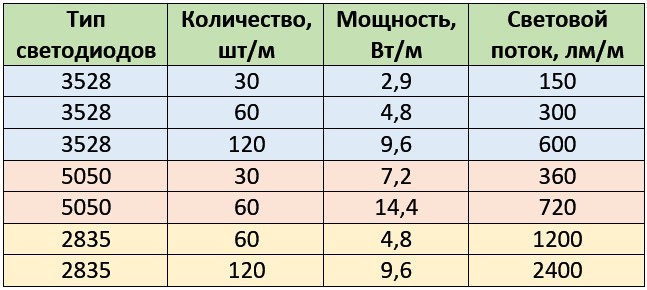
Here, the type of LEDs and the power value for a different number of pieces per linear meter, as well as typical values of the luminous flux, are indicated.
Using it, you can calculate the total power of the LED strip in your installation. Suppose you bought a length of 4 meters with SMD 5050 LEDs 60 pcs / m. Power 1 meter tape 14.4 watts. The calculation of the power supply by power is as follows:
1. Determine how much the load consumes:
14.4W / m * 4m = 57.6 Watts
2.The power supply should be 20-40% more powerful than the load connected to it. The stock is selected based on the conditions of its operation - if it is well ventilated, then 20% is enough, if it stands in a small enclosed space, then 40% may not be enough, especially if, for example, heating is nearby. Suppose we have the first case (we take a margin of 20%), then we need to buy a power supply with a capacity of at least:
57.6 * 1.2 = 69.12 watts
Round up to 70 watts. You can do more, but not less - choose the nearest value available in the store. Below you see a typical range of rated capacities of power supplies with protection class IP20 from the catalog of wholesale suppliers, by the way under the letter B - a power supply unit with active cooling (cooler) is indicated.
But sometimes it happens that the power supply label does not indicate the power, but the maximum output current, then to calculate the current you need to divide the power by voltage:
69.12 W / 12 V = 5.76 A
That is, the output current must be (round) at least 6 amperes.
Wiring diagram
The calculation is quite simple. But there are some features in connecting the LED strip of large length, which is especially true when lighting the ceiling around the perimeter of the room. Consider a few typical wiring diagrams and rules to consider.
The main rule is not to connect more than 5 meters of tape in one line. LED strips are sold in bays of 5 meters for a reason. Their current paths are designed for the current consumption of these 5 meters. If the following pieces of tape are connected to the end of such a segment, then there will be voltage drops to the end of the line, it will warm up and will quickly fail.
TOTAL LENGTH OF ALL CUTS OF LED TAPE CONNECTED FROM OTHER TO ANOTHER SHOULD NOT EXCEED 5 METERS.
If you need to connect more than 5 meters, then there are two options:
1. Route the cable from the power supply to each subsequent length.
2. Lay the 220V cable and connect them to the new power supply.
In the first case, you need to take into account that the wire cross section for the 12V line should be at least 0.75 mm², it is accurately calculated according to the current. For information, 5 meters of LED strip SMD5050 60 pcs / m consumes 72W or 6A current. Here are some typical schemes for connecting an LED strip.
To one power supply for a segment of a total length of up to 5 meters:

Several tapes to one power supply unit with a total length of more than 5 meters:
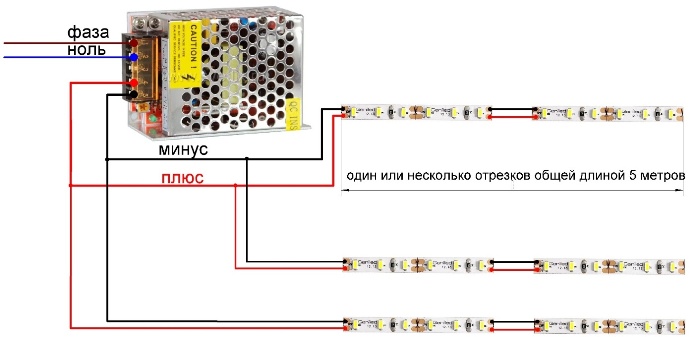
Connecting a long backlight to two power supplies:

As you can see, choosing a power supply for an LED strip is not difficult. There are 3 factors to consider:
1. Location.
2. Tape meter and final connection and installation diagram.
3. The current consumed by the tape.
Thus, you can determine the power and number of power supplies needed to organize backlighting or lighting.
See also on this topic:Calculation, selection and connection scheme of the controller for RGB-tape
See also at bgv.electricianexp.com
:

